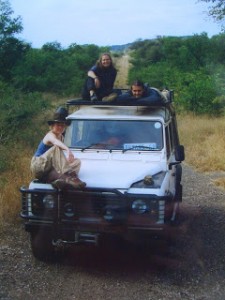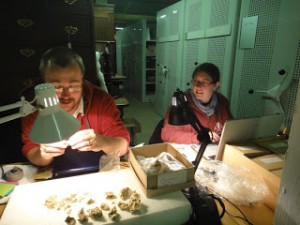Science For Six-Year-Olds (SFSYO for this school year) is a recurring segment on Science Decoded for Mrs. Podolak’s first grade class at Lincoln-Hubbard elementary school. This year the posts are inspired by #iamscience (also a Tumblr) and #realwomenofscience two hashtags on twitter that drove home for me the importance of teaching people who scientists are and what they really do.
Becky: I’m a Palaeolithic archaeologist, which means that I study how people lived during the Stone Age by looking at the things they left behind. “Palaeolithic” actually means ‘old stone age’, and I specialise in the Neanderthals, who were an ancient type of human living in Europe and parts of West Asia between about 300 thousand and 30 thousand years ago. There were four ices ages in the enormous length of time they were around, as well as periods when it was warm like it is now. You will have up to 4% Neanderthal DNA inside you, depending on where your own ancestors come from in the world.
I try to work out how these very successful humans lived, by looking at how they used different types of stone technology to survive (for example they made the first glue, from birch bark pitch), how much they moved around the landscape and what kinds of social networks they had: how often did they meet up with each other.
Becky: I loved learning a lot of different things, including literature, history and science. I also enjoyed art. But when I chose my A-levels (final high school subjects) I took Ancient History (Roman and Ancient Greek), French and English Literature. My school (Graveney School, London) was a comprehensive (not fee-paying) school with a great mix of students from many cultures and backgrounds. I did my first archaeology degree at University of Bristol because they had a rock art course, then I decided I enjoyed human origins and did a Masters in this at University of Southampton. My PhD on the British Late Neanderthals was at University of Sheffield.
Erin: Where do you work and what does a typical day at work entail?
Becky: Right now I work part-time to support my family while I am writing a book and articles on my PhD research. This June I will be starting my first proper science job at the Université Bordeaux in France, thanks to a European fellowship (the Marie Curie program). I will be working with many other specialists from around the world who all study human origins too.My project is looking at the Neanderthals who lived in the mountains and valleys in South-West France, trying to match the stone tools that come from open-air sites with those we have already studied from caves with lots of deep layers of artefacts and animal bones. By looking at the kinds of rock the tools are made from at each site, and where those rocks come from, you can start to map out the territory of Neanderthals in the landscape. From this you can begin to work out how far they travelled, whether they exchanged tools with each other, and how complex their relationships with each other must have been. These are the Big Questions in human origins research!
Becky: I’m a scientist for the same reason that you are all interested in the things you like: everyone has something they’re fascinated by, that they want to know more about. Asking “How?” and “Why?” are things we should never stop doing, and being a scientist means you get to find these things out about the stuff that interests you most. Since I was very young I loved history and imagining what living in the past would have been like, so when I found out that being an archaeologist meant I could do that, I decided that this was the job for me! If I hadn’t become an archaeologist, my other dream job would be an astronomer or a wildlife researcher.
Erin: What is your favorite thing about your job?
The other thing is that working in science means I get to meet amazing people from all over the world who are interested in the same thing as me, and we can share our passion and find new ways to work together.
Becky: Even though it’s true that archaeologists spend time digging, we also spend many hours back at our office or lab, for example I’ve spent months and months studying thousands of stone tools. Even though collecting my data like this can get a bit boring, sometimes it hits you that a real Neanderthal who lived and laughed and enjoyed the sun also held this tool when there were still woolly mammoths and glaciers (ice sheets) a mile thick. That’s pretty awesome to touch the past like that.
Erin: What are your favorite things to do for fun?
Becky: I love getting out into nature especially watching birds (I’m writing a book about birds in prehistory). I enjoy writing about science on my blog, and taking photographs. I really like to play games on the Xbox with my husband, and I have a weakness for science fiction novels.
***
What do you think first graders? I think Becky’s work is pretty cool, do you have any questions for her? Be sure to leave them in the comments. For any adult readers you can catch Becky on twitter @LeMoustier

